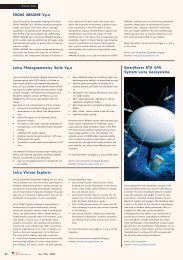2013 - Geoinformatics
2013 - Geoinformatics
2013 - Geoinformatics
You also want an ePaper? Increase the reach of your titles
YUMPU automatically turns print PDFs into web optimized ePapers that Google loves.
34<br />
A r t i c l e<br />
By Paul Ramsey and<br />
David Dubovsky<br />
Although modern open source geospatial software is known to have a lot of<br />
advantages over proprietary, closed source systems, often enterprises find<br />
themselves asking from whom and where they will get support. The emergence<br />
of companies offering enterprise class, commercial support, combined with open<br />
source growth outpacing closed, has enterprises everywhere replacing legacy<br />
software with modern web-based solutions. OpenGeo, and their flagship<br />
product, OpenGeo Suite, has become the choice for those looking for a<br />
comprehensive spatial data platform for the web.<br />
Geospatial Software’s Open Future<br />
O p e n G e o S u i t e 3 . 0<br />
The technology TriMet used— the OpenGeo Suite —packages several<br />
open source projects into a modular enterprise spatial IT solution:<br />
TriMet<br />
In 2007, Portland TriMet was facing a technology conundrum:<br />
though they served a technology-savvy metropolitan population,<br />
which was rapidly adopting transit use, their trip-planning system<br />
presented an old fashioned user interface, backed by proprietary<br />
technology which was difficult to customize and expensive<br />
to scale. To drive and support transit ridership they needed a<br />
quick, easy-to-use trip-planning system that both looked modern to<br />
their users and was built with a modern design, anticipating growth<br />
and adaptation.<br />
TriMet utilized the commercial open source OpenGeo Suite when<br />
building their new public facing maps, including those used in the<br />
online schedules and trip planner. Additionally, TriMet has adopted<br />
open source and open data as central tenets of their systems philosophy:<br />
the data behind those web maps is now all open; and the trip<br />
planning algorithms themselves come from an open source algorithm<br />
which TriMet co-funded.<br />
The reasons TriMet went open source are simple: open source provides<br />
the flexibility to adapt systems to new requirements; open<br />
source provides the scalability necessary to support public facing<br />
web sites; and finally, open source provides the velocity of development<br />
to keep up with the leading edge of technology.<br />
• PostGIS, a spatial database extension for the PostgreSQL database<br />
• GeoServer, a geospatial server capable of connecting to a variety<br />
of data back-ends (e.g., Oracle Spatial, Microsoft SQL Server,<br />
Esri ArcSDE) and publish as OGC services (e.g., WMS, WFS,<br />
WCS, WPS)<br />
• GeoWebCache, a robust caching engine to improve the speed<br />
and performance of serving map tiles<br />
• OpenLayers, a JavaScript library for displaying map data in web<br />
browsers<br />
• GeoExt, a JavaScript library for creating rich map applications in<br />
web browsers<br />
The flexibility of the Suite comes from the ability to incrementally<br />
integrate with existing infrastructures, as TriMet integrated the Suite<br />
with their systems:<br />
• First by bringing in GeoServer to render maps from existing data<br />
formats and database.<br />
• Then building a web interface with OpenLayers/GeoExt, to provide<br />
public web applications for trip planning and map viewing.<br />
• And finally moving the data persistence layer to the<br />
PostGIS/PostgreSQL database.<br />
Unlike many technology platforms, the OpenGeo Suite doesn’t<br />
require organizations to completely re-architect their back-office data<br />
management to start building new applications, and that flexibility<br />
has suited TriMet, and many others.<br />
OpenGeo Suite 3.0<br />
OpenGeo recently released version 3.0 of the Suite, building on the<br />
existing web services, web application toolkit and spatial database,<br />
updating the capabilities of the core components and adding new<br />
features:<br />
June <strong>2013</strong>










